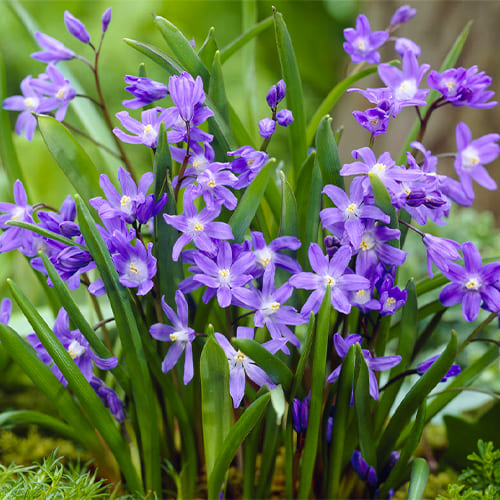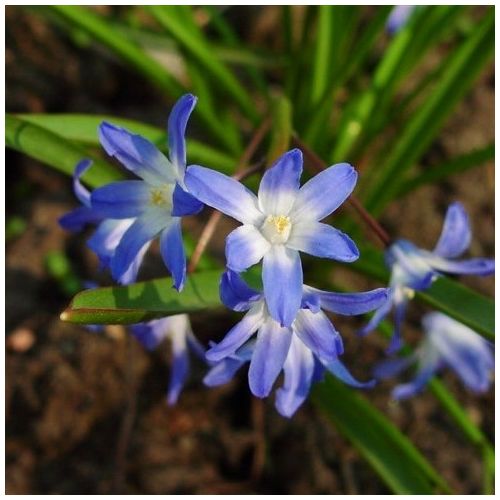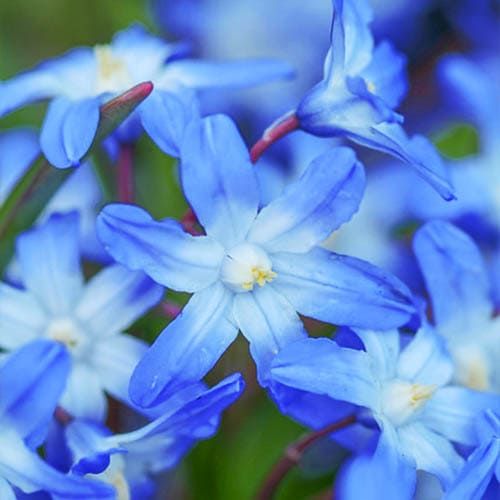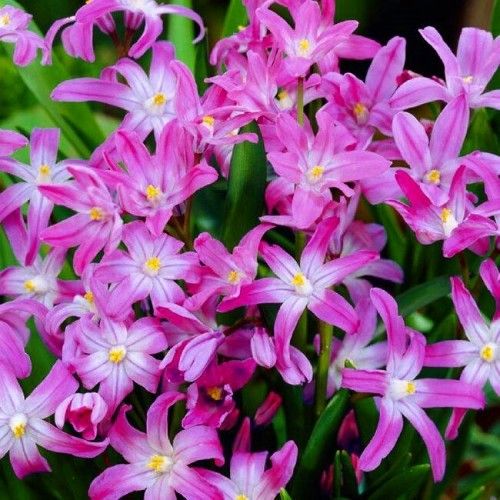
Chionodoxa
Chionodoxa
Last Reviews
Chionodoxa: The Charming Spring Blooms for Your Garden
Chionodoxa presents an incredible opportunity for individuals seeking to infuse their garden with vibrant hues during the upcoming spring season. These delightful petite blossoms serve as the ideal enhancement for any garden or household, infusing an explosion of lively colors and vitality into every corner. Within this piece, we shall delve into the captivating allure of Chionodoxa flowers, providing insights on planting and nurturing them, while also offering design concepts to inspire your imagination as you envision these exquisite blooms gracing your personal garden space.
Exploring the Beauty of Chionodoxa Flowers
Chionodoxa, commonly referred to as the splendid Glory of the Snow, represents a group of diminutive bulbous plants that yield dainty, star-shaped blossoms spanning the color spectrum of blue, pink, and white. Possessing commendable durability and requiring minimal upkeep, these petite blooms have garnered significant favor among garden enthusiasts regardless of their level of expertise.
Chionodoxa Varieties

Chionodoxa bulbs offer a delightful array of varieties, each showcasing its own distinctive traits. Among the most sought-after options are:
1. Chionodoxa forbesii: This particular variety boasts enchanting flowers in shades of blue or pink, complemented by captivating white centers. Notably, it holds the distinction of being one of the earliest blooming bulbs during the spring season.
2. Chionodoxa luciliae: This variety exhibits larger blooms that span the captivating spectrum of blue and pink, also enhanced by their charming white centers.
3. Chionodoxa sardensis: Renowned as the most prevalent choice among Chionodoxa enthusiasts, this variety presents stunningly vivid blue flowers with alluring white centers, lending a vibrant touch to any garden setting.
Characteristics of Chionodoxa Blooms
Despite their modest size, Chionodoxa blossoms possess an impressive capacity to captivate with their vibrant hues and exquisite allure. These petite flowers generally reach heights of 4-6 inches, yet their star-shaped petals weave together to produce a visually striking spectacle within any garden. An additional attribute that sets Chionodoxa bulbs apart is their prolonged flowering duration. Certain varieties have the remarkable ability to bloom for up to six weeks during the spring season. This characteristic renders them an exceptional choice for gardening enthusiasts seeking an enduring burst of color to savor over an extended period of time.
Planting and Growing Chionodoxa Bulbs
Chionodoxa bulbs are characterized by their simplicity of planting and maintenance, rendering them a superb option suitable for gardeners of all skill levels. Here are some tips for planting and growing Chionodoxa bulbs:
Choosing the Ideal Location
For optimal growth, Chionodoxa bulbs thrive in soil that facilitates proper drainage and an abundance of sunlight. It is crucial to select a planting location that fulfills these criteria. Furthermore, these spring bulbs exhibit a preference for cooler temperatures, making them ideally suited for early spring or fall planting. Fortunately, Chionodoxa exhibits adaptability and can flourish in both sunny and partially shaded areas, allowing you flexibility in choosing the perfect spot for their cultivation.
Preparing the Soil for Chionodoxa Bulbs
Prior to embarking on the planting process for your Chionodoxa bulbs, it is crucial to adequately prepare the soil. These bulbs thrive when planted in soil that boasts a favorable combination of rich organic matter and excellent drainage. To ensure optimal conditions, it is advised to enrich the soil by incorporating compost or other forms of organic matter. This preparatory step proves instrumental in facilitating the bulbs establishment of a robust root system, thereby paving the way for the emergence of stunning blooms.
Planting Techniques for Chionodoxa Bulbs
Chionodoxa bulbs should be planted in the fall, before the ground freezes. Plant the bulbs about 3 inches deep and 3-4 inches apart, and water well after planting. These bulbs will begin to bloom in early spring, creating a stunning display of color in your garden. You can also plant Chionodoxa bulbs in containers or window boxes if you dont have space for a garden bed.
Caring for Chionodoxa Bulbs
While Chionodoxa bulbs are generally low-maintenance, implementing a few measures can help ensure their flourishing presence in your garden. Here are some tips for caring for Chionodoxa bulbs:
Watering and Fertilizing
To cater to the preferences of Chionodoxa bulbs, it is important to maintain soil moisture levels that are consistently moist but not overly saturated. Regular watering throughout the growing season will contribute to their well-being. Additionally, applying a balanced fertilizer in the spring and fall can provide the necessary nutrients to promote healthy growth and blooming. However, it is crucial to exercise caution and avoid over-fertilization, as this can harm the bulbs. Striking a balance is key in nurturing their development.
Protecting Chionodoxa from Pests and Diseases
Chionodoxa bulbs possess a commendable resistance to pests and diseases. However, they can be vulnerable to bulb rot if the soil becomes excessively waterlogged. To safeguard against this, it is vital to select well-draining soil for planting and exercise caution not to overwater. Maintaining an appropriate moisture level is crucial. Additionally, it is advisable to remain vigilant for common garden pests such as slugs and snails, which may inflict damage to the foliage of your Chionodoxa bulbs. Prompt action can help mitigate any potential harm they may cause.
Dividing and Propagating Chionodoxa Bulbs
Should your Chionodoxa bulbs become crowded, dividing them in the fall presents an excellent opportunity to propagate new plants. The process is relatively straightforward: carefully dig up the bulbs, separate them into smaller clumps, and proceed to replant them in a fresh location. By undertaking this division, you can effectively disperse the captivating beauty of these spring bulbs across various areas of your garden, ensuring a widespread display of their enchanting presence.
Design Ideas with Chionodoxa
Chionodoxa bulbs offer immense versatility, seamlessly integrating into various garden designs. To inspire your imagination, here are some design ideas showcasing the enchanting presence of these blooms in your own garden:
1. Create a natural, wildflower ambiance by planting clusters of Chionodoxa bulbs along a garden path or within a rock garden. The combination of these charming blooms with other spring-blooming bulbs like daffodils and tulips generates a breathtaking display.
2. For a more structured garden design, incorporate Chionodoxa bulbs alongside perennial plants and shrubs. They harmonize splendidly with companions such as hostas, ferns, and heucheras, adding a touch of vibrancy to the overall composition.
3. Harness the beauty of Chionodoxa bulbs by planting them in containers or window boxes, infusing your patio or balcony with bursts of color. Consider pairing them with other spring-blooming annuals like pansies and petunias for a visually captivating arrangement.
Where to Buy Chionodoxa Bulbs
Chionodoxa bulbs can be conveniently sourced from garden centers as well as online retailers, providing easy accessibility. When selecting bulbs, prioritize firm and plump ones that show no indications of mold or damage. Its worth noting that Chionodoxa bulbs are occasionally available at discounted prices during specific periods, making it beneficial to keep a lookout for deals, particularly if youre working within a budget.
Conclusion: Enchant Your Garden with the Delightful Chionodoxa
Chionodoxa bulbs, with their captivating star-shaped flowers and enduring blooming period, offer an enchanting and effortless way to infuse your garden with vibrant colors and lively ambiance during the spring season. Regardless of your gardening experience, be it seasoned or novice, the beauty and ease of these charming bulbs are bound to captivate and delight. Embrace the allure of Chionodoxa bulbs this spring and witness the magical transformation they bring to your garden firsthand. Give yourself the opportunity to revel in their splendor and experience the joy they bestow.
Frequently asked questions about Spring Flowering Chionodoxa
Where are chionodoxa native to?
Chionodoxa, commonly known as Glory-of-the-Snow, is native to the eastern Mediterranean region. It is primarily found in countries such as Turkey, Greece, and Cyprus.
When grow up chionodoxa?
Chionodoxa typically grows in early spring, usually around March or April, depending on the specific region and climate. This period may vary slightly depending on the local conditions and the specific variety of Chionodoxa.
How to propagate chionodoxa luciliae?
You can use 3 ways to propagate chionodoxa lucilium, namely division of bulbs, sowing of seeds and natural self-sowing.
When to plant chionodoxa?
Chionodoxa bulbs are typically planted in late summer or early autumn, preferably around September or October. This timing allows the bulbs to establish their root systems before winter sets in. Plant the bulbs at a depth of approximately 3-4 inches (7-10 cm) and provide them with well-draining soil and a location that receives partial to full sunlight.
How much water does a chionodoxa need?
Chionodoxa generally requires moderate watering. It prefers moist, well-drained soil. During the growing season, it's important to keep the soil evenly moist but not waterlogged. Water the plants thoroughly when the soil surface starts to dry out, providing enough water to saturate the root zone. However, avoid overwatering, as excessive moisture can lead to bulb rot. In periods of extended drought, it may be necessary to provide supplemental irrigation to ensure the plants receive adequate moisture.
















